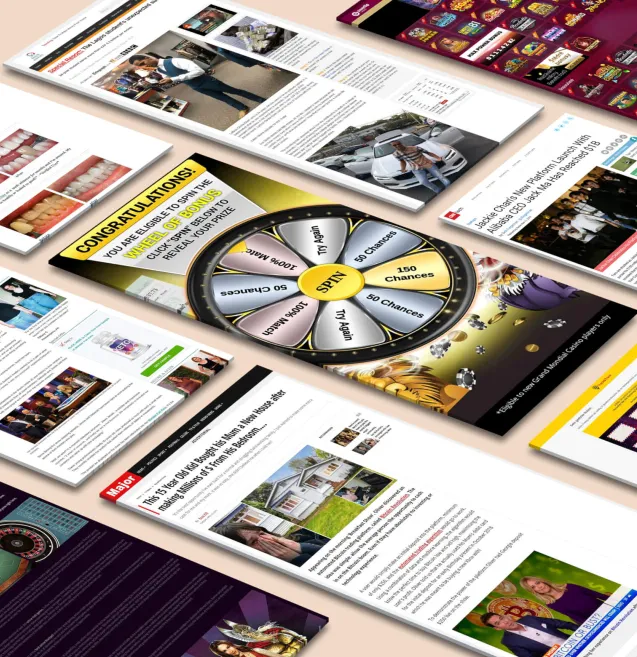
Наши инструменты отслеживают миллионы рекламных кампаний в форматах native, push, pop и TikTok.
НачатьЭтичная реклама всплывающими окнами означает принципиально новый подход цифровых маркетологов к вовлечению пользователей. Вместо того чтобы засыпать посетителей навязчивыми прерываниями, такой подход делает приоритетом уважение, честность и реальную взаимную выгоду. Сфера цифрового маркетинга достигла переломного момента, когда доверие пользователей к всплывающей рекламе напрямую влияет на успех кампании и долгосрочное развитие бренда.
Прозрачность является основой построения такого доверия. Когда вы открыто сообщаете о своих практиках обработки данных, уважаете предпочтения пользователей и создаете рекламу, которая улучшает, а не мешает процессу просмотра, вы налаживаете значимые отношения с аудиторией. Пользователи становятся все более осведомленными об их цифровых правах и ожидают, что рекламодатели будут уважать их конфиденциальность и время.
В этой статье вы найдете руководство по прозрачным стратегиям всплывающей рекламы, которые способствуют установлению подлинных отношений с вашей аудиторией. Вы узнаете о практических способах внедрения этичной рекламной практики, которая защищает конфиденциальность пользователей, соответствует нормативным требованиям и помогает достигать бизнес-целей, не жертвуя при этом целостностью. Ключ к устойчивому успеху в цифровой рекламе — это баланс между прибыльностью и ответственностью.
Этическая поп-реклама — это значительный шаг вперед по сравнению с традиционными агрессивными методами рекламы, направленный на подходы, ориентированные на пользователя, с приоритетом согласия и прозрачности. В основе этической поп-рекламы лежат три фундаментальных принципа: уважение к автономии пользователя, честная коммуникация о сборе данных и минимальное вмешательство в процесс просмотра контента.
Разница между навязчивой и ненавязчивой поп-рекламой заключается в способе реализации и целях. Навязчивые поп-объявления обычно:
Однако ответственная поп-реклама выбирает иной путь. Вы увидите эти принципы в действии, когда реклама:
Представьте сайт, который дожидается, пока вы прочитаете 50% статьи, прежде чем показать одно релевантное всплывающее окно с удобной кнопкой закрытия. Это уважает вашу вовлеченность и при этом позволяет достичь маркетинговых целей. Реклама не перехватывает вашу сессию, а дополняет её, предлагая реальную пользу в подходящий момент.
Пользовательский опыт находится в центре ненавязчивой рекламы всплывающих окон. Когда вы забрасываете посетителей агрессивными методами, вы фактически сообщаете им, что их комфорт не имеет значения. Чрезмерные всплывающие окна, появляющиеся каждые несколько секунд, вызывают раздражение. Автовоспроизведение видео со звуком выбивает пользователей из привычного процесса просмотра. Такие подходы подрывают вашу репутацию бренда быстрее, чем приносят конверсии.
Цифры говорят сами за себя: сайты, использующие агрессивные стратегии всплывающих окон, сталкиваются с ростом показателя отказов до 35%. Пользователи немедленно закрывают вкладки, сталкиваясь с оверлеями, скрывающими контент или делающими навигацию невозможной. Вы теряете не просто потенциального клиента — вы создаёте человека, который будет намеренно избегать ваш бренд.
Уважительная рекламная стратегия требует иного подхода. Ваши всплывающие рекламные объявления должны дополнять процесс просмотра, а не захватывать его. Рассмотрите следующие принципы внедрения:
Можно сохранять видимость без назойливости. Хорошо продуманное всплывающее объявление уважает пространство экрана, позволяет пользователям продолжать чтение и приносит реальную пользу, а не требует внимания через помехи.
Этичная реклама с использованием всплывающих окон: создание доверия без вторжения начинается с честной коммуникации о методах обработки данных. Когда вы точно указываете пользователям, какую информацию собираете с помощью всплывающей рекламы и зачем она вам нужна, вы немедленно создаете основу для доверия. Открытые стратегии всплывающей рекламы требуют четкого раскрытия информации о трекинг-пикселях, файлах cookie и сборе данных о поведении пользователей до того, как они начнут взаимодействовать с вашей рекламой.
Политики конфиденциальности должны быть не просто юридическими документами, спрятанными в ссылках в нижнем колонтитуле. Пользователи должны иметь возможность получить доступ к этим политикам непосредственно из ваших всплывающих объявлений через четкие видимые ссылки или значки. Важен язык, который вы используете: технический жаргон создает барьеры, а простая речь способствует пониманию. Когда пользователи быстро понимают, как их данные перемещаются внутри вашей рекламной экосистемы, они чувствуют, что к ним относятся с уважением и предоставляют им информацию.
Реклама на основе согласия преобразует взаимоотношения с пользователем от пассивного принятия к активному участию. Внедрение механизмов добровольного согласия на сбор данных демонстрирует уважение к автономии пользователя. Вы предоставляете пользователям контроль с помощью:
Раскрытие данных не должно восприниматься как признание — это возможность показать пользователям, что вы цените их доверие. Когда вы объясняете, что сбор данных о поведении в Интернете помогает предлагать актуальные оферы вместо случайной рекламы, пользователи понимают взаимную пользу. Эта прозрачность в стратегиях прозрачной всплывающей рекламы отличает этичных рекламодателей от тех, кто прячется за расплывчатыми условиями использования.
Защита данных начинается с простого вопроса: какие сведения вам на самом деле необходимы? Сбор только тех данных пользователей, которые действительно нужны для персонализации рекламы, демонстрирует уважение к приватности вашей аудитории. Вам не нужно знать все детали истории посещений, чтобы показывать релевантную рекламу. Сосредоточьтесь на тех показателях, которые действительно улучшают пользовательский опыт, не переходя границы допустимого.
Обезличенные данные служат вашей защитой от чрезмерной персонализации. Удаляя персональные идентифицируемые сведения из ваших наборов данных, вы сохраняете возможность эффективного таргетинга, одновременно защищая личную приватность. Такой подход устраняет ощущение дискомфорта, которое возникает, когда реклама кажется слишком проницательной в отношении личной жизни. Вы по-прежнему можете сегментировать аудиторию и предоставлять релевантный контент, не заставляя пользователей чувствовать, что они находятся под наблюдением.
Реклама на основе согласия требует реализации четких механизмов для активации и отключения сбора данных. Пользователи должны сами решать, какие данные вы собираете и как их используете. Речь идет не просто о выполнении требований — это вопрос уважения человеческой автономии. Если пользователь отказался от персонализированной рекламы, немедленно и полностью соблюдайте это решение.
Такие нормативные акты, как GDPR и CCPA, задают минимальные стандарты этичной работы с данными. Эти рамки требуют конкретных мер защиты при сборе, хранении и использовании данных. Вам необходимо понимать эти требования и закладывать их в основу рекламной инфраструктуры с самого начала. Соответствие законодательству — не опция, а основа этичной цифровой рекламы, защищающей как пользователей, так и репутацию вашего бизнеса.
Соблюдение GDPR и соблюдение CCPA являются обязательными требованиями для любого рекламодателя, работающего в современном цифровом мире. Общий регламент по защите данных (GDPR) требует получения явного согласия перед сбором персональных данных европейских пользователей, а Закон о конфиденциальности потребителей Калифорнии (CCPA) предоставляет жителям Калифорнии право знать, какие данные вы собираете, и требовать их удаления.
Для соответствия этим стандартам необходимо внедрить конкретные технические и операционные меры:
Помимо соблюдения закона, этические нормы требуют прекратить использование обманных методов в рекламе. Ваши поп-рекламы никогда не должны содержать вводящие в заблуждение заголовки, сулящие одно, но предлагающие совсем другое. Кнопка «закрыть» должна быть хорошо видна и легко доступна — её нельзя скрывать или размещать таким образом, чтобы пользователи случайно переходили по вашей ссылке.
Честная коммуникация означает точное и без преувеличений описание вашего предложения. Если вы предлагаете бесплатный пробный период, укажите точно, когда начнутся взимание платы. При сборе адресов электронной почты четко обозначьте, как вы будете их использовать. Такой прямой подход создает доверие, которого невозможно достичь только соблюдением правил.
Этичная поп-реклама: построение доверия без вторжения меняет то, как бренды взаимодействуют со своей аудиторией. Применяя прозрачные стратегии поп-рекламы, вы вкладываетесь в отношения, которые выходят далеко за рамки одного клика или конверсии. Бренды, которые придают приоритет честной коммуникации в своей рекламе, отмечают заметное улучшение показателей удержания клиентов и увеличение их пожизненной ценности.
Связь между этичными практиками и репутацией бренда основана на простом принципе: пользователи запоминают, как вы заставляете их чувствовать. Когда ваши поп-рекламы уважают их время, приватность и интеллект, вы создаёте положительные ассоциации, влияющие на будущие покупательские решения. Компании вроде Patagonia и The Honest Company построили целые бизнес-модели вокруг прозрачности, что показывает: доверие пользователей к поп-рекламе напрямую связано с лояльностью к бренду.
Постоянная честность в рекламных взаимодействиях означает:
Уважение проявляется в конкретных решениях. Вы предоставляете пользователям контроль над их рекламным опытом с помощью легко находимых кнопок закрытия, ограничений частоты показов, предотвращающих рекламную усталость, и ясных предложений ценности, объясняющих, почему им стоит взаимодействовать. Эти практики со временем накапливаются, формируя основу доверия, которую конкуренты, использующие агрессивные методы, не могут повторить.
Устойчивая монетизация требует тонкого баланса между получением дохода и соблюдением этических норм. Вы можете добиться прибыльности, не жертвуя доверием пользователей, применяя стратегии всплывающей рекламы, которые уважают опыт и конфиденциальность вашей аудитории. Ключ в том, чтобы рассматривать этические практики не как ограничения, а как инвестиции в будущее вашего бренда.
Диверсификация источников дохода уменьшает зависимость от агрессивных рекламных тактик. Рассмотрите следующие подходы:
Вы обнаружите, что диверсификация обеспечивает стабильность. Когда всплывающая реклама является лишь одним из элементов вашей стратегии монетизации, вы можете позволить себе быть избирательными и этичными в ее использовании. Этот подход защищает ваш бизнес от колебаний доходов и демонстрирует уважение к предпочтениям пользователей.
Постоянная оптимизация поддерживает эффективность вашей этичной стратегии всплывающей рекламы. Регулярное A/B-тестирование помогает определить, какие форматы, частота и размещение рекламы приносят доход, не ухудшая при этом пользовательский опыт. Вам следует отслеживать такие показатели, как частота отказов, продолжительность сессий и коэффициент конверсии, наряду с данными о доходах. Такой комплексный взгляд гарантирует, что вы не жертвуете долгосрочными отношениями с пользователямиади краткосрочной выгоды.
Инвестиции в этичную инфраструктуру окупаются снижением оттока пользователей, улучшением восприятия бренда и увеличением пожизненной ценности клиента.
Прозрачная реализация рекламы требует конкретных мер, которые превращают этические принципы в операционную реальность. Вам необходимо создать четкие механизмы, которые наделяют пользователей правами, одновременно защищая интересы вашего бизнеса.
Механизмы получения согласия должны использовать простой язык, исключающий юридические формулировки. Размещайте флажки для согласия в заметных местах, куда пользователи смотрят естественным образом, избегайте предварительно отмеченных флажков, которые подразумевают согласие. Сделайте процесс отказа от согласия одинаково доступным — пользователи не должны проходить через множество страниц или обращаться в службу поддержки, чтобы отозвать согласие. Предоставьте детализированные параметры, позволяющие пользователям выбирать конкретные категории данных, которыми они готовы делиться, вместо вынужденного выбора «всё или ничего».
Уведомления о конфиденциальности должны объяснять практику сбора данных простым языком до того, как пользователи столкнутся с первым всплывающим объявлением. Четко укажите, какую именно информацию вы собираете, как используете, кому предоставляете доступ и как долго храните. Разбивайте сложную информацию на понятные разделы с использованием заголовков и маркированных списков. Приведите реальные примеры, иллюстрирующие вашу практику работы с данными: «Мы используем историю просмотров, чтобы показывать вам релевантные рекомендации товаров», что эффективнее, чем расплывчатые заявления о «улучшении пользовательского опыта».
Платформы управления согласием на использование файлов cookie, такие как OneTrust, Cookiebot и TrustArc, упрощают реализацию прозрачной рекламы. Эти решения обеспечивают настраиваемые баннеры, соответствующие требованиям GDPR и CCPA, сохраняя при этом эстетику вашего сайта. Панели управления конфиденциальностью дают пользователям централизованный контроль над своими предпочтениями в отношении данных при многократных посещениях сайта.
Преимущества этичной рекламы во всплывающих окнах выходят далеко за рамки немедленных конверсий—они создают устойчивую основу для цифрового успеха. Когда вы уделяете приоритетное внимание формированию доверия пользователей через прозрачные практики, вы инвестируете в отношения, которые приносят стабильный доход на протяжении времени.
Дальнейший путь требует приверженности следующим основным принципам:
Этичная реклама во всплывающих окнах: создание доверия без вторжения—это не просто формальное соответствие требованиям—это конкурентное преимущество. Бренды, которые применяют эти стратегии, позиционируют себя как надежные партнеры в условиях все более скептически настроенного цифрового пространства.
Готовы изменить свой подход к рекламе во всплывающих окнах? Ознакомьтесь с отраслевыми отчетами Бюро интерактивной рекламы (IAB), изучите требования GDPR и CCPA, а также анализируйте кейсы брендов, успешно внедряющих прозрачные рекламные стратегии. Ваши пользователи—и ваша прибыль—благодарны вам за переход к этичной, ориентированной на доверие рекламной практике, уважающей как бизнес-цели, так и человеческое достоинство.
Получайте лучшие конверсионные лендинги каждую неделю на свою почту.
Советы и хитрости
Расширение глобальных кампаний всплывающей рекламы требует правильных стратегий геотаргетинга. Изучите пять проверенных подходов к масштабированию всплывающей рекламы в различных регионах с сохранением высокой результативности. Узнайте, как адаптировать креативы, время показа и сообщения под местную аудиторию и культурные особенности. Идеально подходит для рекламодателей, готовых уверенно выводить свои кампании с всплывающей рекламой на международный уровень.
David Kim
7 миндек. 11, 2025
Инструкция
Elena Morales
7 миндек. 10, 2025
Инструкция
ИИ меняет подход рекламодателей к поп-кампаниям в 2025 году. Узнайте, как автоматизация, прогнозная аналитика и оптимизация в реальном времени могут улучшить таргетинг и повысить вовлеченность. Получите практические советы по созданию более эффективной, высокорезультативной поп-рекламы, приносящей измеримые результаты. Идеально подходит для маркетологов, готовых оставаться впереди в быстро меняющемся мире рекламы, управляемой ИИ.
Priya Kapoor
7 миндек. 8, 2025




